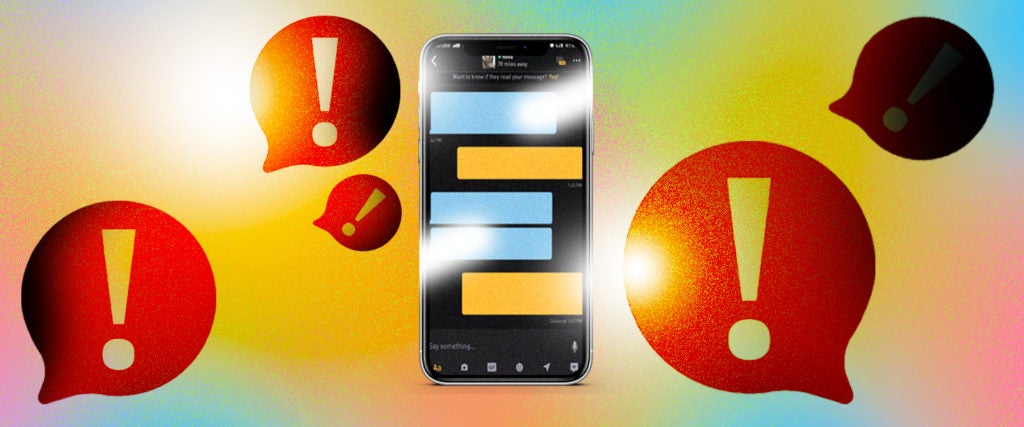Anthony had a bad feeling about Matt. They’d been seeing each other for about six months, but he was rattled by an incident during a recent threesome the two had together. During that encounter, Matt, a cis man, hadn’t used a condom during sex with Anthony, who is trans, or with the third man they’d invited to join them, who was also trans. Anthony knew Matt had sex with other men — the two weren’t exclusive — but Matt promised he always used condoms when he had sex with anyone else.
“I started feeling a little alarmed that I was being lied to,” says Anthony, a pseudonym (all of the names in this story have been changed to protect the identity of the individuals involved). Upset with Matt and worried about his condom use with other partners, Anthony turned to Grindr and Scruff — but not for sex. He wanted information. Knowing Matt generally hooked up with trans men, Anthony began by messaging other transmasc-identified users on the apps. “I got hits pretty quick,” he tells me. “As I got more information from other people, my message started changing to a ‘Hey, has this guy ever assaulted you? Are you okay?’ kind of message.”
The more people Anthony messaged, the more replies he received with stories about Matt. Some users confirmed Anthony’s fears about Matt refusing to wear a condom during sex; others sent Anthony screenshots of abusive messages they’d received from him on the app, or related instances of meeting up with Matt and feeling pressured or coerced into having sex. One user, another trans man, claimed he and Matt broke up because Matt physically assaulted him.
“I was like, ‘Okay, there’s something really wrong with him,” Anthony says. “So I confronted Matt, like, ‘There’s all these people saying you’ve done all this fucked-up shit to them. What’s up with that?’ He blocked me and never spoke to me again.”
But breaking up with Matt wasn’t enough. “That’s when I was like, ‘Okay, I’m worried for the community because I’m hearing more and more back from these guys.” And so, Anthony teamed up with a friend to spread the word to other trans men on Grindr. “We started sending a warning message saying, ‘Hey, there’s this guy who preys on people in the community.’”
For over a year and a half now, Anthony has tracked Matt’s location through dating apps and contacted any trans man within a plausible radius of his ex. “It’s actually quite concerning how easy it is to find someone’s near-exact location with these apps,” Anthony explains. “I was able to find his profile by using advanced search and filling in info I recalled.”
Once Anthony faved Matt’s profile, it became even easier to track him. “He had distance and global on for his profile, so it wasn’t hard to slide into the explore search bar and slide the map around until I found his profile bumped to the top of the page,” Anthony continues.
During his first few months of outreach in late 2018, Anthony estimates he sent around 80 messages to other trans users on popular dating apps for gay men. While he was alerting everyone he could in their DMs, Anthony also reached out to the apps themselves. “I tried to get him off the app site during the time that I was active on sending warnings out,” he tells me. “I’ve sent out multiple reports. I’ve had friends send out their reports. I’ve tried to get with AVP.org to get with Grindr, but something fell through.”
Ultimately, Anthony never heard back from Grindr or Scruff, and he says Matt’s accounts are still active — in fact, he has multiple accounts on Grindr. “Somebody sent me a screenshot of their block list, and it has two accounts with [Matt’s] face on it,” he says. (Though he does know that at least one of Matt’s accounts “was legit banned from Grindr.”)
While this stands in direct contrast to how easy it is to get someone kicked off of Tinder, per a ProPublica report, dating apps handling reports of potentially dangerous users on their platforms (including registered sex offenders) with silence and inaction is standard practice. ProPublica also notes that Grindr “makes no promises to block accounts” of users who are accused of rape, and adds the app doesn’t “conduct criminal background checks on members.” Scruff’s terms of service similarly claim the app “does not conduct criminal or other background checks on its users, but reserves the right to do so at any time.”
Scruff didn’t reply to my request for a comment. And despite multiple clarifications that I was a reporter inquiring about a story, a Grindr rep replied via email that “the project you describe would be in direct violation of Grindr’s Terms and Conditions of Service, particularly, Section 8.” My understanding here is that they were referring to Anthony’s “project,” not Matt’s behavior. (They declined to elaborate further on how that could possibly be the case.) As for Section 8, it’s all about user guidelines, which basically prohibit anyone from using Grindr for any reason besides hooking up.
Disappointed by the apps’ inaction, Anthony felt compelled to continue tracking Matt’s movements. He estimates he’s now sent about 250 warning messages that have changed from his first fact-finding questions in late 2018. “It definitely evolved from, ‘Hey, has this guy harassed you or said transphobic stuff?’ to more recently, ‘Hey, this guy is a dangerous predator,’ to specifically saying, ‘Hey, I’m sending out a warning to the community about a particular individual named Matt. He has assaulted several individuals in the community, if you or somebody you know has been assaulted by this man, I can provide further information about him to help you to make a report.’”
Not everyone Anthony has reached out to, though, has appreciated the warning. A few asked him to add a trigger warning, which he has. Others are ambivalent about Anthony’s entire outreach project. Elliot, a trans Scruff user who was contacted by Anthony, feels conflicted about his approach to other trans men. “What’s complicated for me is that I do believe in communities taking care of each other, and warning people about rapists,” Elliot writes via email. “I’ve done this, but almost always face-to-face with someone who I think is in danger. It makes me feel like these guys see themselves, and me, as uniquely vulnerable, and probably unable to hold my boundaries or advocate for my needs during the course of a hookup. I’ve spent a long time figuring out how to access cis gay male sexual spaces; I’ve gotten very good at it, and any reminder that I’m somehow more fragile gets my goat.”
When users like Elliot reply with objections, Anthony says, “I try not to argue with them about it. I just say, ‘I’m just really trying to protect the community from this person.’” And unless apps like Grindr and Scruff become more responsive to user complaints, he can’t think of a better way than to do what he’s doing.
Michael Munson, the executive director of FORGE, a national organization dedicated to serving trans survivors of assault, intimate partner violence and stalking, points out that Anthony’s methodology isn’t particularly unusual. “This strategy of warning people of dangerous or abusive people has been a primary strategy of helping communities stay safer,” he tells me. “We often aren’t able to find other ways of communicating with folks about who might be dangerous, harmful, engage in stealthing or any other behavior that may hurt others, so this form of electronic warning is often useful and effective.”
Overall, he says, there’s no secret solution in terms of how trans men can protect themselves and one another from dating violence or harassment. “The answer to this is the same as any other man (or person of any other gender) protecting themselves. Warning folks of people is one way — especially when there’s a person who exhibits repetitive harmful behavior.” He also stresses the importance of being “knowledgeable and aware of power and control tactics, which could escalate over time — and heed those warning signals if things start to head down those roads.”
“It may sound a bit like the onus is on the non-abusive person to take action rather than placing responsibility on the person who is acting harmfully,” he continues. “Of course, it’s the responsibility of each person to act in ways that don’t (non-consensually) hurt others. But sometimes what we have available to us is our own behavior to try to reduce risks and minimize violence.”
Minimizing the potential for violence is Anthony’s primary aim, but he also knows he can’t control how anyone receives his messages. “Best-case scenario, anybody that’s currently involved with Matt has the information that they deserve to make their own informed decisions about staying with him,” Anthony concludes. “I just want to be able to provide any information to anybody that needs to make a report or needs closure.”

